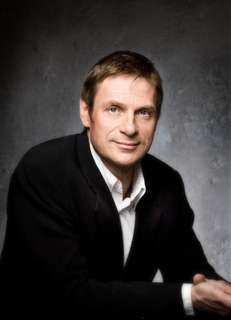|
Back
Simon Keenlyside: Musical Miniaturist New York
Alice Tully Hall
02/28/2010 -
Robert Schumann: Dichterliebe, Op. 48
Franz Schubert: Selected Songs
Hugo Wolf: Selected Songs
Simon Keenlyside (Baritone), Pedja Muzijevic (Piano)

S. Keenlyside (© Uwe Arens)
Several years ago, during an interview with the Guardian, Simon Keenlyside said that “[e]verything that happens in your life – the good and the bad – is somewhere in my box of song texts or lieder or French song.” This comment goes a long way toward explaining the extraordinary sense of authenticity, intensity, and immediacy with which he sings. There is nothing artificial or applied. This is not to suggest that Keenlyside in recital merely serves up some sort of artless stream-of-consciousness musical autobiography. Far from it. He’s a consummate artist. He is also a visual artist, well known for his marvelously mischievous caricatures. Uniquely in my experience of recitals, Keenlyside imparted a visual dimension to the music.
First up on the program was the perennial Dichterliebe, sung with his beautiful, richly resonant voice and keen sensitivity to dynamic nuance. The songs reminded me of quick charcoal drawings or water color studies -- with a telling gesture here, a dab of color there. Keenlyside revealed a mastery of line but also of color. His palette was so varied, extending from his sonorous lower range (in “Im Rhein, im heiligen Strome”) to a ravishing head voice. But he did not hesitate to bleach out all the color when the text called for it, letting his voice go white. His word painting throughout was superb. Two particularly fine examples were in “Im wunderschönen Monat Mai,” on the words “mein Sehnen und Verlangen” (my longing and desire) and in “Aus meinem Tranen spriessen,” on the words, “Lied der Nachtigall (song of the nightingale). His diction and phrasing were also excellent.
In addition, Keenlyside, noted for his on stage physicality in opera roles, conveyed so much by simple means – the tilt of his head, a hand gesture, or a pose. And he seemed to draw the audience and the space of Alice Tully Hall into the world of the songs. They became miniatures of exterior and interior landscapes. Keenlyside lavished attention and artistry on every song, but they never felt precious or overdone. And he had a superb collaborator in pianist, Pedja Muzijevic, whose contributions were fine throughout, but most notable in the Schumann, which is almost a duet. Highlights of this section of the program included a hushed, gorgeously sung “Am leuchtenden Sommermorgen” (where he seemed to draw us into magical space) and a poignantly vulnerable “Ich hab’ im Traum geweinet.”
Next, Mr. Keenlyside moved on to four songs by Hugo Wolf, settings of poetry by Eduard Mörike. For this section, he gave us a variety of nature studies and, in “Auf eine Christblume II,” a lyrically stunning aural and visual image of a butterfly in flight. In “Lied vom Winde,” Keenlyside showed his mastery of both declamatory and lyrical types of lieder singing.
Last on the program were nine songs by Franz Schubert, an interesting mix of the familiar, “An Sylvia” and “Ständchen,” for example, and less well known songs like “Verklärung” and “Himmelsfunken.” “Ständchen” was simply enchanting – sung with great tenderness and charm and just the right touch of rubato. It ended with a smile and a sigh. But it was the last two that were, for me, the highpoint of the recital. “Verklärung” (Transfiguration) was a tour de force. Keenlyside alternated declamatory passages with those that were more lyrical. In the latter, he bleached the color from his voice and used half voice to magical effect, as he sang of floating upward out of life and the world vanishing amid angel harmony. “Himmelsfunken” (Intimations of Heaven) was sung with soft, utterly ravishing head voice and seamless legato to evoke God’s breath.
In a song I know from Fischer-Dieskau’s recordings, “Die Sterne,” Keenlyside looked up into the distance as he sang. He was under the flickering stars and so were we. There were three encores, the most moving of which was lyrical “Nachtviolen,” which he dedicated to his daughter who was about to be born.
This was not his first recital in New York. But there was a particular excitement in the hall, almost certainly perhaps because he was soon to make his role debut as Hamlet at the Metropolitan Opera, just across the road. So this recital was a bit of a preview. And it was a fascinating one because, just as Keenlyside sings opera with a lieder singer’s sense of text, he brings to lieder a keen theatricality, particularly evident in his use of space. He will be back at the Met next season as Posa in Nicholas Hytner’s new production of Don Carlo. He will also return to Alice Tully Hall for a recital with Emmanuel Ax.
Meanwhile, he can be heard on a marvelous CD in the Wigmore Hall Live series, which – happily – includes several songs he sang in recital, including the Schubert and Wolf lieder I particularly liked, as well as songs by Faure, Ravel, and an encore, Poulenc’s “Hotel.” The pianist on the disc is the remarkable Macolm Martineau, who will also be back in New York next season, in a Carnegie Hall recital with Bryn Terfel.
Arlene Judith Klotzko
|